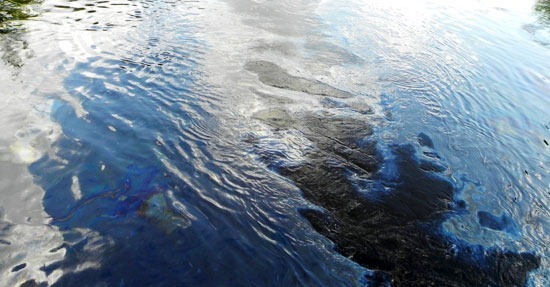Cleanup of Kalamazoo River oil spill will take months
0
Oil on the Kalamazoo River. Although most of such oil on the surface has been cleaned, it is still embedded in riverbank soil, floodplains, and riparian vegetation.
A series of mandatory tests will soon begin on the oil pipeline that ruptured last month and sent roughly 820,000 gallons of crude oil into a Lake Michigan tributary.
When Canadian pipeline company Enbridge Inc.’s line 6B ruptured, oil gushed into a tributary of the Kalamazoo River, which flows directly into Lake Michigan. The pipeline carries approximately 8 million gallons of oil per day from Griffith, Ind., to Sarnia, Ontario.
Enbridge officials said they’re not sure when the federal government will allow them to begin using the line again, but they must first perform high-pressure tests in six sections of the pipe that might have infirmities similar to the segment that breached on July 26. Water will be pumped into a portion of the pipe that is about a dozen miles long.
The Detroit Free Press reports that regulators from the U.S. Pipeline and Hazardous Materials Safety Administration have raised concerns on numerous occasions regarding Enbridge’s procedures for identifying and repairing pipeline problems.
A public meeting regarding the spill aftermath and cleanup was hosted by the Environmental Protection agency on Thursday in Kalamazoo County, Mich. Federal, state and local officials addressed the concerns of about 100 people who attended the meeting.
The first five miles of the river downstream of the spill were affected most by the oil, where thick layers of it reached from bank to bank for several days after the rupture. The oil, however, never made it past Morrow Dam in Comstock Township, Mich.
“This is where we took a stand in our attempt to stop the oil from going further downstream,” EPA regional director Susan Hedman said during the meeting.
Initial concerns were that the massive sheens of oil would make it into Lake Michigan, but Hedman said that the lake is no longer at risk and that the oil will not make it past the dam.
The oil did, however kill fish, coat hundreds of animals with oil, and foul the shoreline. Moreover, some riverside residents voluntarily left their homes because of oil fumes.
The EPA has approved all of Enbridge’s cleanup plans, and oil is successfully being removed from all areas of the 30-mile stretch of the river affected by the spill, from where the pipeline broke to downstream Morrow Lake.
Although most of the oil from the river’s surface has been cleaned, it is still embedded in riverbank soil, floodplains, and riparian vegetation.
About 1,500 workers are still performing cleanup and remediation tasks, and the effort is expected to last several more months. Long-term testing and monitoring to assess the impacts left by the oil will continue for years, said Mark Durno, EPA’s deputy incident commander for the spill.
Enbridge preparing to test oil pipeline as months of cleanup and monitoring from spill remain [MLive.com] Report: Enbridge pipelines have been worry for years [The Detroit Free Press]
Image Credit: http://greatlakesontheground.com/













